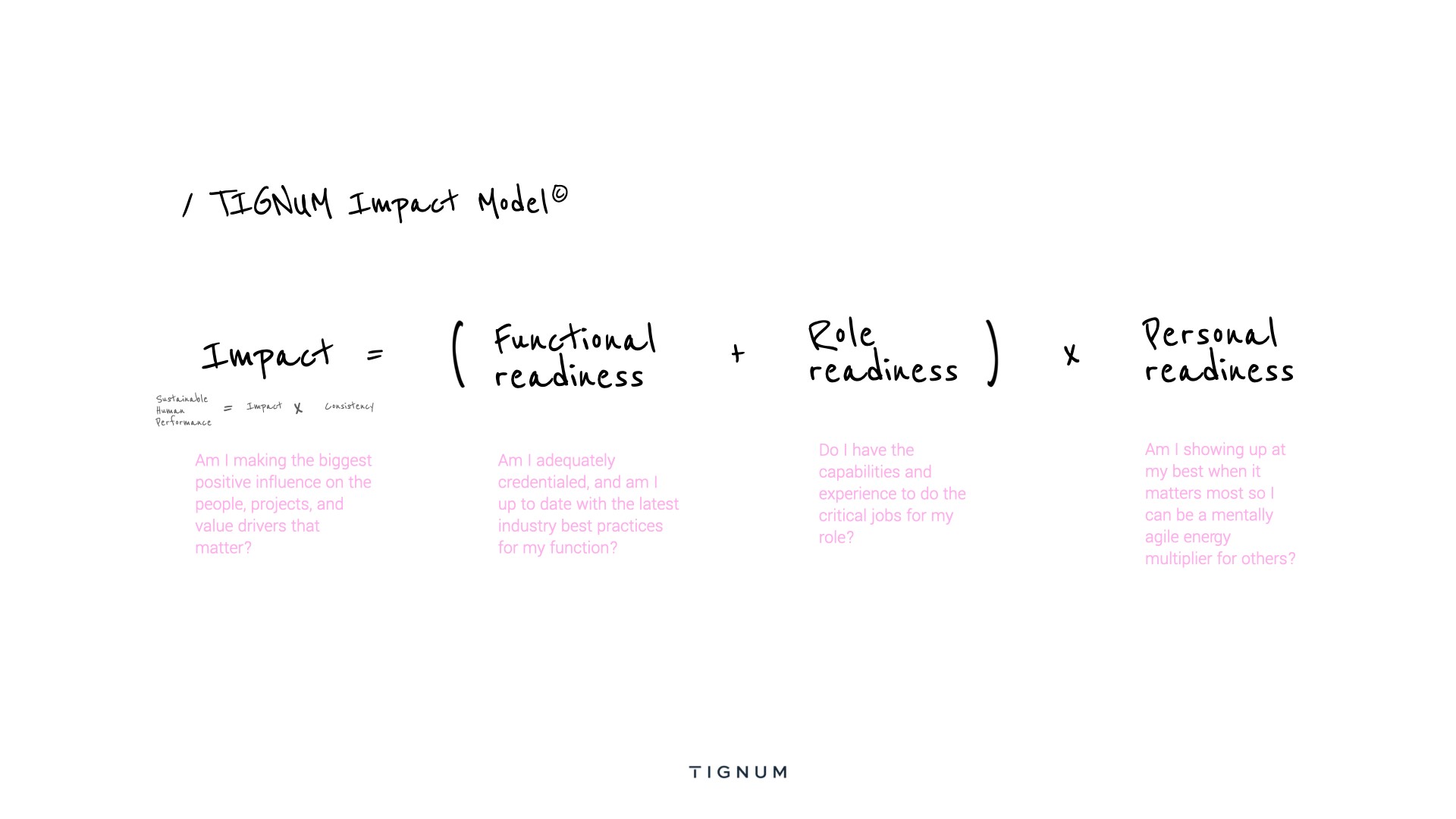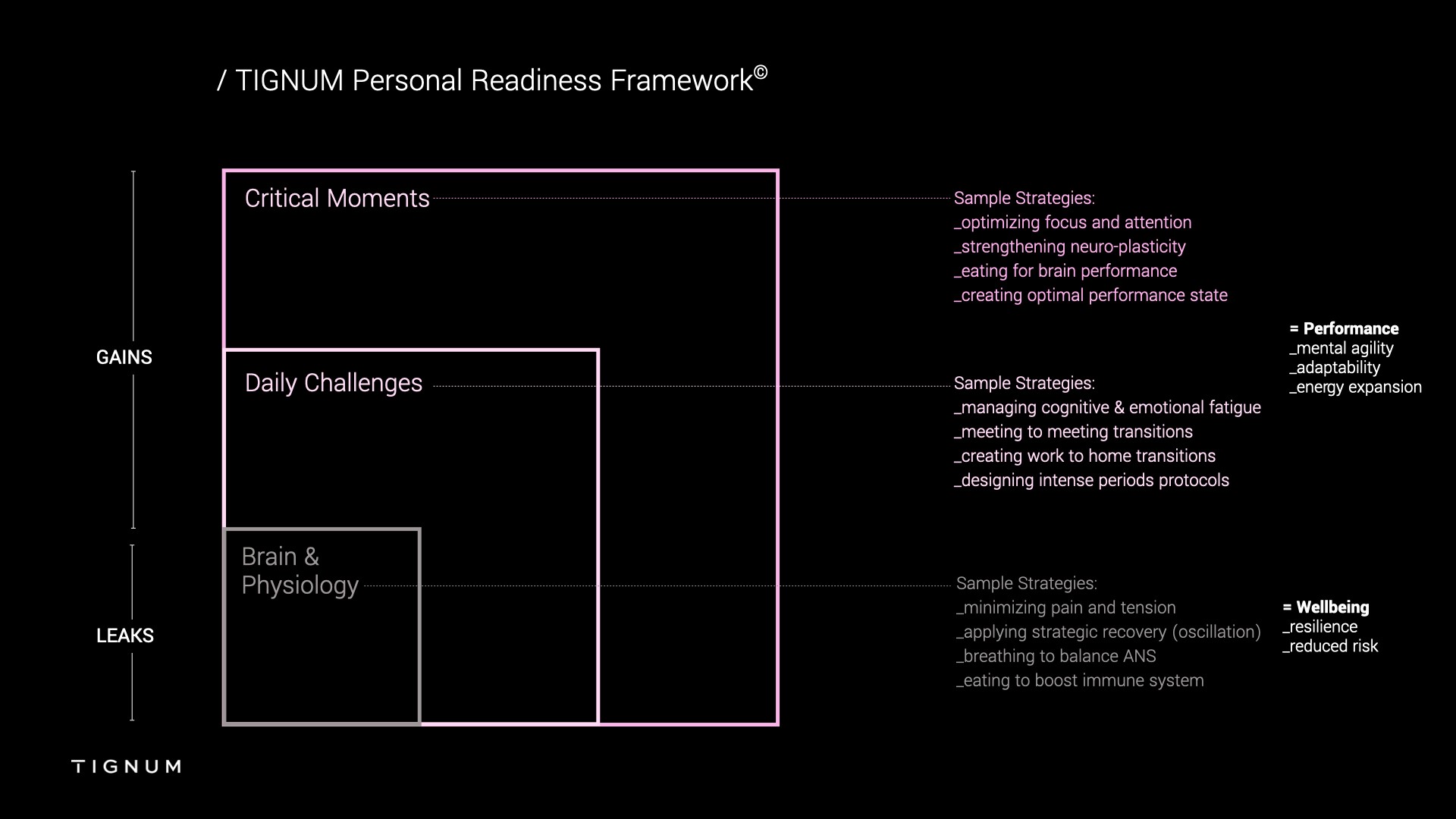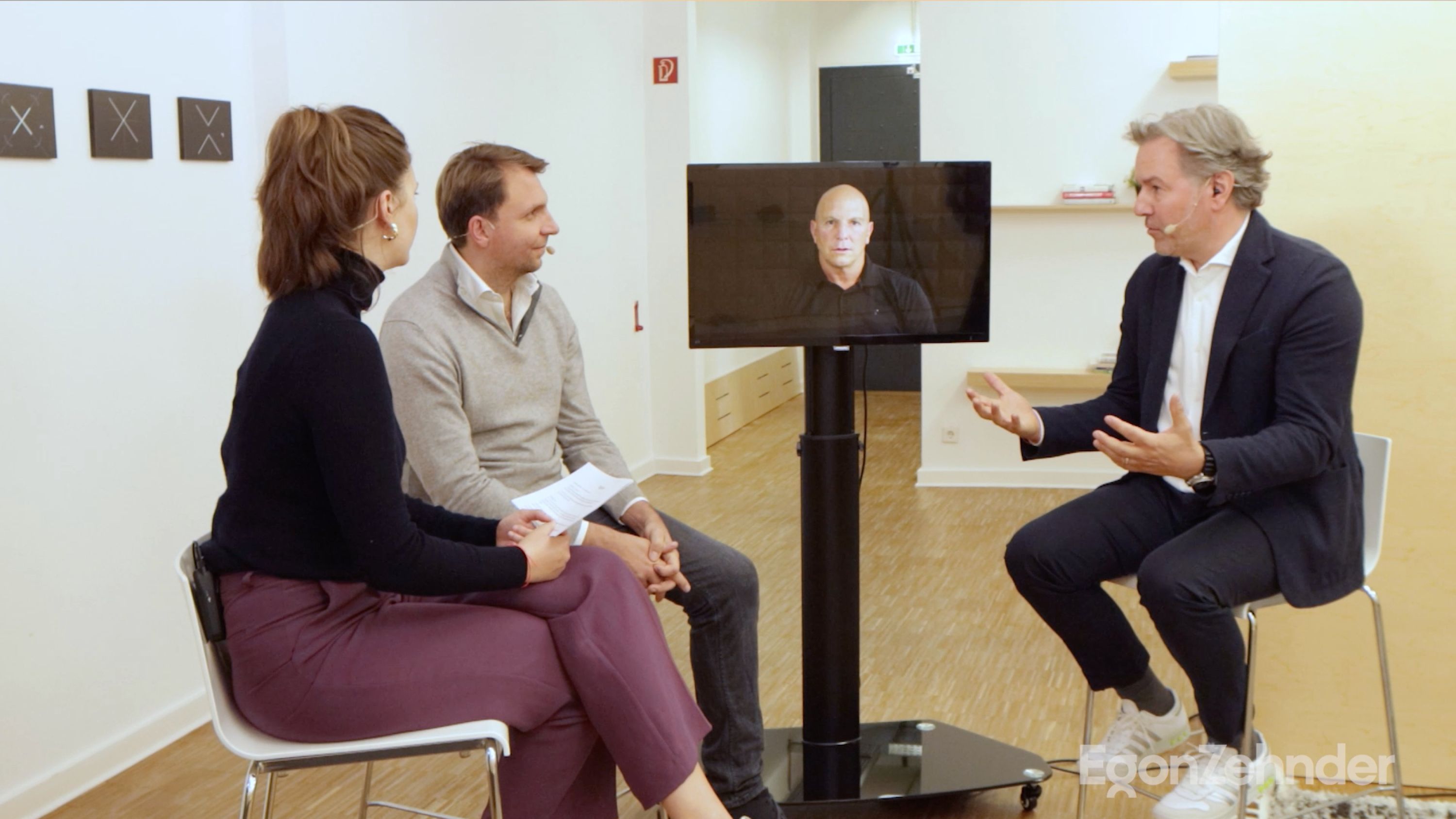CEO Jogi Rippel and Chief Performance Officer Scott Peltin discussed some fundamentals of Tignum’s approach, busting myths along the way. For Jogi and Scott, stress is not the enemy – it is our greatest performance enhancement tool. While calmness and focus are certainly important, continuous serenity may not be what you need. And discipline is fatiguing, so you can’t always count on it alone. Instead, Tignum’s founders advocate adopting a toolkit of quick, easy situation-specific techniques for leaders who seek to maximize their impact in all situations.
Jogi and Scott met nearly two decades ago at a training facility for elite athletes. The two men – a marketing entrepreneur and a fire battalion chief – bonded over a passion for the fundamentals of sustainable human performance. Since then, they have built well-tested and pragmatic techniques for leaders, grounded in a science-based, data-driven methodology.
Jogi joined us in person, while Scott appeared via video conferencing. During our conversation, they were both notably focused and alert – two leaders who practice what they preach, staying fully present and attuned to the occasion.
Getting Stronger from Stress
We asked Tignum’s founders what sustainable human performance is about, why it is such a challenge nowadays, and how to attain it.
Jogi: Sustainable human performance for us is about how you show up, how you think, how you prepare for meetings, how you are in meetings. In a nutshell, it’s about how to create impact. We look at sustainable human performance on three levels. Firstly, from a brain and physiology point of view. Are all your systems in your body working at full capacity?
The second level is about daily challenges. Can you move through the day with all your different challenges and deliver impact and high performance?
The last level is about critical moments. How can you be your best at those critical moments? This level is a true multiplier – and busy, overwhelmed leaders need to leverage every multiplier they can.
We’re trying to focus on how you can be more mentally agile and have high performance resilience. How to have energy, give energy, multiply energy. Society is in a crisis loop, and the toll on leaders is huge. They constantly need to change plans, come up with new solutions, be highly adaptable. We’re seeing that most people are not prepared. They don’t have the tools and strategies, and as a consequence, they don’t have the mental agility or resilience they should have. There’s huge fatigue. They’re struggling.
Scott: Why are we getting weaker from stress when we should get stronger? Everywhere in our physiology, when we get loaded and then recover, we get stronger. So, can I break my day up so that I can recover between my work? And can I make that recovery part of my transition and my preparation, so that I’ll be better going into the next event?
There are micro-tools, like breathing, where I can purposefully alter my energy state. When I’m choosing the right tool, I ask myself questions like whether I need to be calm or transmit energy. Transmitting energy doesn’t mean being loud. Many people think of an energy multiplier as someone who’s just boom, boom, boom. But our research shows that energy multipliers are curious. They ask great questions. They’re great listeners, compassionate, empathetic. And when you go between events, if you can’t change gears quickly, you’re not only wasting time, but your brain isn’t performing to solve your new problem.
Imagine you just came from one meeting where you were dealing with employees involved in the Ukrainian crisis. Now you’re dealing with a completely different issue that might have to do with a strategy you’re working on for the next six months. The Tignum methodology is built around tools that I can choose to apply, depending on the challenges I have right now.
Jogi: When the Covid hit, everybody rolled up their sleeves and said, “Okay. How can we solve this crisis?” But the longer the crisis went, the more people were fatigued. We thought, “How is that possible? They’re sleeping in their own bed. They’re not traveling, so no time zone differences. They don’t commute. Our data showed that they were sleeping longer. So why are they fatigued?”
Then we realized it wasn’t physical fatigue. Our data clearly showed that leaders were experiencing very different types of fatigue: cognitive and emotional exhaustion. This decade is hugely challenging, with all its transformations and crises – AI explosion, digital cars, climate change, supply chain problems. On the one side, you have fatigue. On the other side, you have complex problems to solve as teams, as leaders. That’s brutal, right?
When people are fatigued, they quickly back into habitual behavior. Biases come out. They take shortcuts. They get maybe irritated. They’re less curious. All the things you shouldn’t do to solve those complex problems. That’s why the costs are huge. We call the struggle we see at the moment an impact crisis. How can you create more impact in this complex world of constant change and crisis?
Scott: You need a robust toolbox – you can’t use one tool. I’ll just give you an example. Meditation is a great tool for a cognitive reset and for reducing overall stress. But for many people who have relied on that to help them get through the day, by 1pm, they’ve been bombarded by so much that they need to check out and start all over. Or they may need some micro-tools that they can apply right now, a quick mental imagery, a quick reset with their intentions, a breathing technique that works in one minute rather than 20-30 minutes.
It’s the same with exercise. I get up in the morning, do some rigorous exercise, and feel energized. Does my adrenaline response last the whole day? Not when my fatigue later on is a combination of physical fatigue from my workout and cognitive fatigue from sitting in Zoom meetings, having to come up with new answers and solve problems. I need to select the movement that sets me up for success the whole day – and I may need to use movement throughout my day to re-activate my brain and energize myself.
Also, I might have emotional fatigue. Let’s say I have employees in Ukraine and in Russia, and on social media people are demanding that we do the right thing – but the right thing is complicated. It’s not just black and white, because we don’t live in a black-and-white world. My physical recovery tools simply won’t work here. That’s where I need a robust toolbox.
Going Beyond Wellbeing
Jogi: Every organization tries to solve some of those challenges with wellbeing programs. But what wellbeing says, more or less, is: eat clean, move more, sleep more. When you do that, you feel better. When you feel better, you perform better. We’re saying it’s way more complex, because each day I might have different challenges, and the load and intensity may increase.
Scott: Executives are right that they might not have time to do something that’s going to take 30 minutes. But in one minute, I can set my intentions before I walk in, asking how I want to be perceived, what I want people to know, how I want them to feel. I can decide my optimal performance state, the level of energy I should have. I can check whether I’m primed to be curious and compassionate. If I don’t spend that time, I’m trusting that I’ll just go in and wing it. But none of us are good wingers. Great experience might help, but it’s almost an arrogant stance to say, “I don’t have time to show up at my best”. And it’s dangerous when you’re making critical decisions.
Jogi: What we think should happen right now is a paradigm shift in thinking. Suppose a leader goes into a tough, intense, must-win project, but with an additional requirement: at the end of the project, we not only won’t be exhausted or burned out – we will all be 10 percent better and stronger. Imagine what kind of shift that is. Right now, when we talk about human performance, it’s often about avoiding crisis: we need to make sure nobody falls over, nobody crashes along the journey. We can’t push too hard because we need to be careful. That thinking is, in our view, way too small. It’s like climbing a mountain. When you make it to the peak, do you expect to need a rescue helicopter to bring people down? No, they need to walk down together. In a critical project, you have to be able to take the mission all the way to completion.
Scott: If you think about human physiology, we’re built to get stressed, recover, and rebuild stronger to be ready for the next stress. If I’m an executive, on a day where I’m go, go, go, what I may be missing is the opportunity to get stronger. Where do I put those periods to regenerate and replenish? Some of that happens at the macro level. Over the course of the year, I may have opportunities to check out, reset my autonomic nervous system (fight or flight), and refocus on what’s important. But even on a weekly basis or a daily basis, I can purposefully take moments to reflect and recharge, to reprocess the stress I was just under. Then, rather than it being a trauma or a stressor that lives on, I’ve reprogrammed it in my brain to be a lesson that I learned from.
There’s a huge power to a whole team creating a subculture around sustainable human performance. They speak the same language, use the same tools, have the same commitment to getting stronger from stress, want to show up better at home. Some leaders and teams will bring us in because they want that kind of culture, and we help them build that. Then they’re ready for the next crisis, so that they can ask: What do we need to do now? What are our timelines? What are the human performance requirements at each milestone?
Jogi: When something unexpected happens, I may be too fatigued to create a new plan. But in our way of thinking, we create plans ahead of time, and work through them. That’s what a sustainable human performer would do. Then, depending on the circumstance, I choose an approach I already know.
Becoming Who You Want to Be
We were keen to hear from Tignum’s leaders about how leaders can make the most of work and leisure, what techniques are most effective for acquiring new habits, and whether their approach has a measurable impact.
Scott: Most people don’t plan their vacation like a high performer. They know when and where they want to go, and who’s going with them. But they don’t think, what would success look like at the end of this vacation? Who do I want to be at the end? And they don’t follow a process to make the transition from being on at work to being off. Then they don’t transition back from vacation to work. Their brain is kind of mushy from being on vacation, and they get hit with a tsunami of demands. That’s a lack of preparation.
We’ve worked with many executives to help them use processes to plan the vacation, and to refocus as they transition back from vacation. They ask questions like: What’s a priority when I come back? What are the three projects I need to work on? Who are the five people I need to connect with immediately to move something forward? That way, they overcome inertia and start to build momentum.
As for habits, when we built our model of how you build and change habits, we went back to the drawing board to think about what really works for people and what doesn’t. Think about a habit. It starts as a choice: I have to decide between one thing or the other. Then, I consciously determine the benefits of choosing a particular option. If I repetitively pick that option, I habitualize it. I do it unconsciously. To decide what habits I want to develop, I have to step back to the foundation. How do I define myself, and what behaviors or choices will help me be that person? And how can I break those behaviors down into small ones, so that I can build momentum? What doesn’t work is discipline – because discipline fatigues. If I think that I just need to get harder, tougher, more disciplined, I will get fatigued and my discipline will wane. I’ll judge myself, and be filled with shame and guilt. Then I won’t want to take on a new habit or try again. That’s the worst place to be.
Jogi: It’s not about discipline or grinding more. It’s about having a clear ‘to-be vision’ – how you actually want to be, and be perceived, in all your different roles. A lot of people still think of the tools as being part of the soft field of wellbeing. But to understand how our tools and strategies improve business results, we’ve done many case studies. For instance, we’ve had two teams taking on identical tasks – one team we’ve worked with, one we haven’t. Then we compared the business outputs, which were very different.
In another case, we worked with a team that had to launch new products in China every four weeks to push the competitor off the podium within six months. The team was exhausted. Numbers were really bad. We helped them to reengage, raise energy, be prepared with tools. In six months, we pushed the competitor off the podium. With comparisons using control groups, and quantifiable successes, the benefits are very clear.
Scott: In some ways, the business world is where athletic training was thirty years ago. Mindset training for athletes was just: be tough. Toughen up. Grind it out. And a lot of athletes burned out, and had very short careers. Now we’re in an era where great athletes, like Roger Federer and Rafael Nadal, sustain their career. We’re in the greatest era of human performance in sports because athletes are applying tools and techniques. So we should be careful about what we perceive as soft.
Jogi: Our research shows that there’s an impact crisis: leaders are saying clearly they’re not having the impact they want. We have physiological data, behavioral data, performance habits data, behavioral preference data, all these kind of things – but in a nutshell, it’s about output. And if leaders aren’t able to create the impact they need, especially in these tough times, that’s sad. To dial into the right emotional state with the right intentions – that’s the secret. There are meetings where I need to be pushy, maybe a little bit aggressive, to achieve results. And then there are times where I need to be humble, play down my ego, and listen more. If you’re fatigued, such changes are hard. That’s why it’s critical to equip people with the tools and strategies to use fast, on the go, between meetings.
As a leader, during the day, there’s so many occasions where you have to make an impact and touch people. If you can’t do that because your tank is almost empty and you don’t have the energy, you lose. But when there are leaders and teams that are using human performance tools to achieve a massive impact on critical projects, and getting better through crises rather than weaker, then their energy will radiate through the whole organization. We need more energy multipliers in the business world, and fewer energy suckers.
Passionate leaders with innovative solutions transmit plenty of energy, and we still felt the buzz after our meeting. For one thing, we were intrigued by the idea of having a set of fast-acting tools to align your mindset with your upcoming needs. In a day of varied meetings and events, all requiring top form, such preparation serves as a huge boost. Our conversation with Jogi and Scott had expanded our minds – and left us eager to try Tignum’s methods out.
Video: A Conversation on Sustainable Human Performance in Times of Crisis








